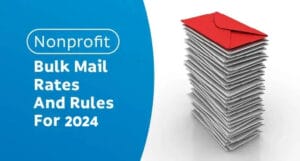Is Direct Mail Junk Mail?
Let’s be real, finding “Unsolicited Mail” in your mailbox is the worst. That’s why so many recipients see “junk mail”, while marketers only see advertising.
What is it about these mailers that cause people to throw them out? “Junk mail” is often mail that is unaddressed, unsolicited, or simply irrelevant to the recipient. No one wants to receive mail that doesn’t have them in mind.
But the biggest objections that recipients have? They are simply not interested in an advertisers’ product. When people receive advertising for things they haven’t expressed interest in they begin to wonder, “how the heck did they find me?” and that creates a negative impression. People receive so many ads daily that they are eager to opt out of junk mail and unwanted marketing.
When you create a mailer it is important to develop an attractive looking piece that draws in your recipients. However, it is easy to focus solely on the aesthetics of your piece and underestimate the importance of how relevant the mailer is.
Another hot topic about direct mail is its environmental impact: each year 100 million trees are cut down to provide paper for brochures, catalogs, and flyers. Unfortunately, 70% of them end up in the trash. Using recycled paper or materials will create a positive impression on your recipients, as well as help preserve the environment.
Read also IS DIRECT MAIL JUNK MAIL?
Understanding the background
Why do marketers send “unsolicited mail” in the first place? To get new clients, increase foot traffic to their store, build brand recognition, ask for a supportive donation, or to invite folks to a special event.
Why do people open and read a direct mailer? According to the Marketing-GAP report, the most common reasons are:
- It is personally addressed to them,
- It’s from a brand they know or from a local service,
- They are interested in the product or service,
- The mailer offers a great deal, a discount or a voucher, and some free samples to try.
It is important to remember that very few will open and read a mailer because it’s fun or looks interesting. Design, colors, and an attractive envelope matter the least.
All of these tactics must be combined in order to have a successful mailer.
The 40/40/20 rules of the relevance
The famous 40/40/20 principle of marketing design was developed by the lead marketing expert Ed Mayer in the early 60s’.
Ed’s principle states that in the success of a marketing campaign:
- 40 percent is based on reaching the right audience, that means using the right mailing list.
- 40 percent is based on the relevancy of the offer you are making.
- The remaining 20 percent is based on everything else – size and format, postage rate, paper quality, used colors, copy, design.
The science of engaging people with the highest probability of buying is a fine matter. Before buying a mailing list, you need to create a buyer persona profile by carefully choosing demographics and psychographics such as lifestyle, interests, frustrations, age, and buying preferences.
To understand better the right audience for you, examine your current customer base, conduct surveys to find trends with clients, and talk to your sales department about their experiences when reaching out to consumers.
Another great way to gather this data is by looking into the analytics of your website to see what types of users have been your best customers in the past.
In order to keep your offers in people’s minds cater your mailer to your consumer’s needs, centering it around the problem your product solves. One of the most effective tools for increasing sales conversion is to offer an incentive that appears to be high in value. Offering a “limited time offer” is a great way to pique interest and elicit a quick response from your recipients.
Segmentation & Personalization
If you run a niche business and are looking for a way to reach a very specific market, the targeted mailing is one of the best ways to accurately reach your potential clientele and cut down junk mail.
The main advantage of the targeted mailing strategy is segmentation. You can identify a specific category of prospects with clear demographics and buying preferences. Then, send a customized mail piece with a relevant offer to each of your specific market segments.
The second benefit of targeting is that you can add personalization, that means you can place the names of your prospects and precise directions to your nearest store in the individual messages. That will definitely increase your response rate, due to the personal engagement of your customers with the mailer.
Create a personal connection
Research shows that when an offer is presented in a distancing manner, it is highly unlikely that your offers will get a response. This is the moment when the personal connections come into play. Forming emotional connections with your customers creates a preference for your business experience. That’s how they choose businesses they enjoy to work with over those who don’t bother to personalize their customers’ experience.
Using positive emotions to appeal to your prospects is another way to encourage personal investments. Using positive imagery and wording will encourage your leads. If people feel happy when they interact with your material then that is what your business will represent in their minds. Offer a solution to their problems and your product will quickly come to mind.
Another possible tactic is to use powerful negative emotions, such as fear or anger. These tactics can be very impactful if consumers are running from the Big Bad Wolf, whatever it may represent in their lives. These emotions are easier to incite and manipulate, so use them in a responsible manner.
Sales expert Geoffrey James explains that all buying decisions come down to these following six feelings:
- Greed for being rewarded.
- Fear of missing out or getting in trouble.
- Altruism for the desire to help others.
- Envy for someone else’ wins.
- Pride for boosted self-image.
- Shame, to avoid future mistakes.
Some tips for using emotions in your mail campaign:
Use strong words to embody the emotion: “reward” for greed, or “lose” for fear. Emphasize personal benefits. Talk in terms of teamwork for altruism, show outcomes for self-pride, or reveal what they miss or lose for fear. We are not suggesting for you to play with emotions, but to feel and empathize!
So, how can you stay relevant with direct mailing? Offer great deals, choose your audience carefully and create a personal connection with them. The last ones help us to set preferences and make decisions.




